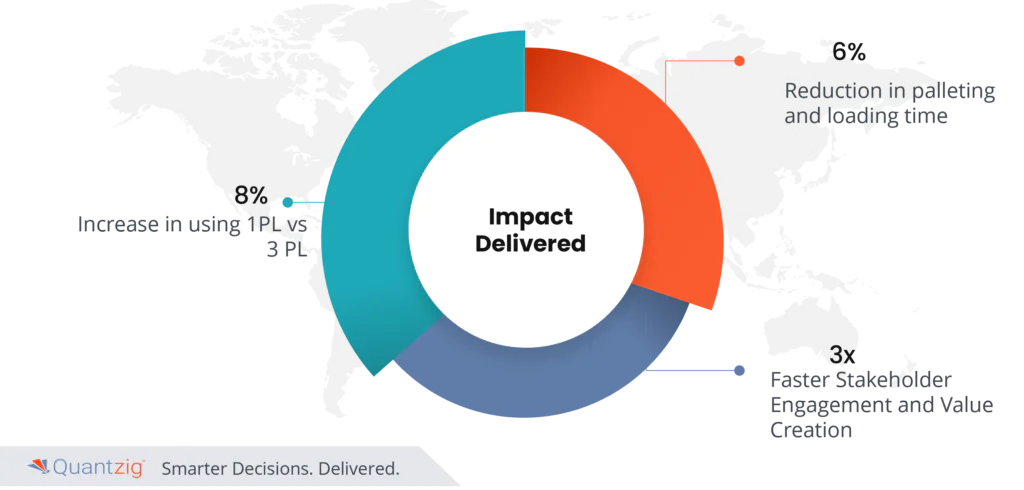Written By: Sudeshna Ghosh
In the fast-paced landscape of supply chain management, enhancing warehouse efficiency is paramount for sustainable success. This article delves into the critical intersection of technology and warehouse operations. Unveiling the transformative power of system development, the article explores strategies to elevate visibility within warehouses, optimizing processes from inventory tracking to order fulfillment. In an era where precision and real-time insights are integral, this comprehensive guide addresses the pressing need for advanced systems. For professionals aiming to stay ahead in the competitive arena of logistics, understanding and implementing Warehouse Management optimization system development is the key to unlocking unparalleled visibility and operational excellence.
Don’t miss out on this vital resource – read on to revolutionize your warehouse management practices and propel your business to new heights!
Book a demo to experience the meaningful insights we derive from data through our analytical tools and platform capabilities. Schedule a demo today!
Request a Free DemoTable of Contents
Importance of Warehouse Management with System Development:
In the dynamic landscape of contemporary network operations, the imperative for success lies in the implementation of efficient and streamlined processes. Warehouse Management Systems (WMS) emerge as the linchpin in this pursuit, playing a pivotal role in the optimization of operations. These systems fundamentally contribute to enhanced efficiency and accuracy by optimizing tasks and automating workflows. The result is a seamlessly orchestrated warehouse environment, fostering not only precision but also considerable cost savings. Through the reduction of labor and operational costs, organizations can attain increased profitability, positioning them strategically in the competitive market. Furthermore, the integration of WMS elevates customer satisfaction by ensuring swift and accurate order fulfillment, a crucial factor in the contemporary consumer-driven marketplace.
Beyond immediate advantages, WMS provides a foundation for scalability and adaptability, essential elements for sustained growth. As businesses evolve and expand, the adaptability of WMS allows for a seamless transition, ensuring that the operational backbone of the warehouse aligns with the organization’s changing needs. In essence, the holistic integration of Warehouse Management Systems not only optimizes current operations but also lays the groundwork for a resilient and scalable infrastructure, positioning businesses for success in the ever-evolving landscape of network operations.
Why is Warehouse Optimization Required?
E-commerce logistics have become increasingly crucial for businesses, with their reputation and revenue streams heavily reliant on efficient warehouse optimization. This process encompasses various aspects, including customer satisfaction, 3PL fulfillment company services, and supply chain management. To ensure sustainable business growth, internal procedures must align with the chosen business model, focusing on maximizing warehouse storage capacity and inventory capacity.
Process automation plays a pivotal role in warehouse optimization, targeting redundant processes and inefficient space utilization. By integrating warehouse management software and inventory management systems, businesses can streamline warehouse operations and enhance overall efficiency. Physical automation, such as automated picking systems and mobile/wearable technology, complements these efforts, further improving productivity and accuracy.
Warehouse automation stats indicate a significant impact on picking, packing, and shipping processes, reducing errors and minimizing operational costs. However, businesses should be mindful of potential challenges, such as inaccurate inventory processes, which can be addressed through continuous improvement initiatives. With proper implementation of automation, warehouses can experience notable improvements in performance and resource utilization, leading to enhanced competitiveness in the market.
What are the Benefits of Warehouse Optimization?
Warehouse optimization plays a crucial role in the success of modern businesses, offering numerous benefits that directly impact their bottom line and operational efficiency.
1. Cost Reduction:
One of the primary reasons for prioritizing warehouse optimization is its ability to significantly reduce operational costs. By maximizing inventory capacity and warehouse storage capacity, businesses can minimize the need for additional space or storage facilities, thereby lowering overhead expenses. Moreover, streamlining warehouse operations through process automation and physical automation reduces labor costs and minimizes the risk of errors, further contributing to cost savings.
2. Enhanced Customer Satisfaction:
Efficient warehouse optimization directly translates to improved customer satisfaction. By optimizing picking, packing, and shipping processes, businesses can ensure faster order fulfillment and accurate deliveries. This leads to happier customers who receive their orders promptly and in pristine condition. Additionally, implementing warehouse management software enhances visibility into inventory levels, allowing businesses to prevent stockouts and fulfill customer orders more reliably.
3. Competitive Advantage:
In today’s competitive market, businesses must strive to differentiate themselves from their competitors. Warehouse optimization provides a significant reputation boost by showcasing a company’s commitment to efficiency and reliability. By leveraging advanced warehouse automation technologies such as automated picking systems and mobile/wearable technology, businesses can outpace competitors in terms of order accuracy, delivery speed, and overall operational efficiency.
4. Scalability and Adaptability:
As businesses grow and evolve, their warehouse operations must adapt to changing demands and market conditions. Warehouse optimization facilitates scalability by allowing businesses to efficiently utilize existing resources and infrastructure while accommodating growth. Moreover, the flexibility offered by process automation enables businesses to quickly adapt to fluctuating demand patterns and market trends, ensuring agility in response to changing customer needs.
5. Enhanced Customer Satisfaction
Warehouse optimization significantly enhances customer satisfaction by ensuring timely and accurate order fulfillment through streamlined picking, packing, and shipping processes. By leveraging warehouse automation, including automated picking systems and physical automation technologies like mobile and wearable technology, businesses can eliminate redundant processes and mitigate inefficient space utilization, thus maximizing warehouse storage capacity and inventory capacity.
6. Increased Revenue Streams and Business Growth
Warehouse optimization drives revenue streams and business growth by improving internal procedures and warehouse operations. With enhanced inventory management through warehouse management software and inventory management systems, businesses can minimize the occurrence of inaccurate inventory processes and achieve greater supply chain efficiency. Overall, warehouse optimization serves as a cornerstone for success in the competitive landscape of e-commerce logistics, bolstering reputation and fostering long-term business model sustainability.
In summary, warehouse optimization is essential for businesses looking to stay competitive in today’s dynamic marketplace. By focusing on cost reduction, customer satisfaction, competitive advantage, and scalability, businesses can unlock significant value and position themselves for long-term success.
What are the Ways to Optimize your Warehouse?
In today’s rapidly evolving business landscape, optimizing warehouse operations has become paramount for ensuring efficiency, cost-effectiveness, and customer satisfaction. From streamlining fulfillment processes to leveraging cutting-edge automation technologies, warehouses face numerous challenges in their quest for operational excellence. This introduction sets the stage for exploring five key strategies to enhance warehouse performance. By prioritizing safety protocols, embracing automation solutions, and staying agile in response to market changes, businesses can unlock the full potential of their warehouse operations. Let’s delve into these pointers to uncover the path towards warehouse optimization.
1. Implement Automation Solutions:
To enhance efficiency and reap financial benefits, consider integrating automation technologies such as robotics, IoT sensors, and automated storage and retrieval systems (ASRS). These technologies streamline inventory management processes, minimize human error, and improve warehouse productivity.
2. Prioritize Safety:
Ensure safety protocols are in place to protect employees and minimize the risk of insurance claims. Provide proper training on safety precautions and the use of safety equipment like fire extinguishers and emergency exits. Additionally, invest in LED lighting and install mirrors to enhance visibility and mitigate accidents.
3. Optimize Space Utilization:
Maximize space within your warehouse by adopting a flex design approach and employing humancentric design principles. Utilize IoT sensors to monitor space utilization and identify opportunities for improvement. Regular inventory audits help identify and address inventory location problems, ensuring optimal use of available space.
4. Enhance Fulfillment Processes:
Streamline order fulfillment operations by leveraging technologies like barcode scanning and RFID tags. Implement a warehouse management system to improve inventory visibility and accuracy, reducing the occurrence of mistakes and inventory miscounts. Utilize shipping solutions from carriers like USPS, UPS, and FedEx to expedite deliveries and enhance customer satisfaction.
5. Stay Agile and Adaptive:
Keep abreast of market changes and trends to maintain ecommerce success and capitalize on first-mover advantages. Continuously plan and forecast future needs, adjusting warehouse layout and operations accordingly. Foster transparency throughout the organization to facilitate collaboration and drive success in the long term.
By incorporating these strategies into your warehouse optimization efforts, you can create a safer, more efficient, and adaptable warehouse environment that drives business growth and customer satisfaction.
What are the challenges while implementing Warehouse Management with System Development?

Outdated Systems & Fragmented Data:
- Outdated Systems: Using obsolete or outdated warehouse management systems (WMS) can impede operational efficiency and hinder the ability to adopt new technologies. It may lead to slower processes, increased errors, and difficulties in integrating with other modern solutions.
- Fragmented Data: When data is scattered across various systems that do not communicate effectively, it creates a lack of visibility. This fragmentation can result in delays in decision-making, as real-time insights become challenging. The integration of data across platforms becomes crucial for streamlined operations.
Inaccurate Inventory, Overstocking, and Under stocking:
- Discrepancies in Inventory: A mismatch between the physical stock on shelves and the recorded data in the system can lead to inaccuracies. This can result from manual errors, theft, or system glitches, impacting order fulfillment and customer satisfaction.
- Overstocking: Holding excess inventory ties up capital, increases storage costs, and may lead to obsolescence. It can also result in markdowns and reduced profit margins.
- Understocking: Insufficient inventory can result in stockouts, delayed shipments, and dissatisfied customers. Lost sales opportunities and potential damage to the brand’s reputation are common consequences.
Slow Order Processing:
- Adaptation to Demand Fluctuations: Warehouses need to swiftly adapt to sudden changes in demand, whether it’s a surge or a dip. This requires flexible staffing models and adaptable warehouse arrangements to efficiently handle varying workloads.
- Inefficient Fulfillment Processes: Slow and inefficient order processing can lead to delayed shipments, missed delivery deadlines, and ultimately, dissatisfied customers. Optimizing fulfillment processes, from order picking to shipping, is critical for meeting customer expectations and maintaining a competitive edge.
In addressing these challenges, implementing modern WMS, integrating systems for seamless data flow, conducting regular inventory audits, employing demand forecasting tools, and optimizing fulfillment workflows through automation can significantly enhance warehouse management efficiency. The use of competitive keywords such as “real-time integration,” “agile fulfillment,” and “demand forecasting technology” underscores the importance of staying at the forefront of technological advancements in warehouse management.
How does Quantzig’s Warehouse Management with System Development provide Benefits in the manufacturing industry?

Boutique Solutions for Diverse Warehouse Management Needs:
- Tailored Solutions: Our suite of solutions is customized to meet the unique and varied requirements of Warehouse Management optimization. Tailoring solutions ensures that our clients receive precise tools and strategies that align with their specific operational challenges.
Cost Optimization Across Various Dimensions:
- Transportation Cost Optimization: We specialize in strategies to minimize transportation costs, leveraging advanced algorithms and intelligent routing to streamline the movement of goods efficiently.
- Pallet Cost Optimization: Our solutions focus on optimizing pallet utilization, minimizing storage costs, and maximizing space efficiency within the warehouse, ensuring cost-effectiveness in the use of pallets.
Addressing Unpredictable Customer Order Patterns:
- Proactive Approach: Given the unpredictability of customer order patterns, we adopt a proactive approach. This involves using advanced analytics and forecasting tools to identify and prepare for potential order fluctuations and variations in demand.
- Order Pattern Identification: We assist clients in identifying the most likely order patterns for each customer, helping them anticipate demand shifts and allocate resources accordingly.
Optimal Distribution Setup Challenges:
- Vendor-Cost Models: Dealing with diverse cost models across vendors adds complexity to planning optimal distribution setups. Our solutions are designed to navigate and optimize distribution setups considering the varying cost structures of different vendors.
- Planning for Variability: Planning for optimal distribution setups becomes challenging due to the inherent variability in customer orders. Our tools account for this variability, providing dynamic solutions that adapt to different order scenarios.
Automated Simulation-Driven Distribution Cost Minimization:
- Simulation Technology: Our solution employs cutting-edge simulation technology to forecast customer orders under optimistic and pessimistic scenarios. This simulation-driven approach allows for a comprehensive analysis of potential outcomes and the identification of optimal distribution setups.
- Cost Minimization Tool: The core of our solution is a sophisticated cost minimization tool that dynamically suggests the ideal 3PL (Third-Party Logistics), order quantity, and pallet sizes based on the unique parameters of each customer order possibility.
Dynamic Forecasting and Customized Simulations:
- Dynamic Forecasting: Our solutions use dynamic forecasting techniques to adapt to changing market conditions and customer behaviors, ensuring that distribution setups remain optimized in real time.
- Customized Simulations: Tailored simulation solutions are integrated to account for the specific needs of each client, allowing for accurate predictions and actionable insights into the distribution network.
In essence, our comprehensive suite of solutions leverages cutting-edge technology, proactive forecasting, and dynamic simulations to Warehouse Management optimization, ensuring cost efficiency, and agility in the face of unpredictable market dynamics. Key competitive keywords include “proactive forecasting,” “cost minimization,” “simulation-driven solutions,” and “dynamic optimization.”
Quantzig’s Success Story:
Client location:
US
Challenges faced by the client:
The client, a US-based Consumer Packaged Goods (CPG) manufacturer, faced several challenges in their logistics operations, resulting in inefficiencies, erratic fulfillment, excess costs, and poor customer satisfaction. Here are the key challenges the client was grappling with
Erratic Fulfillment:
- Order Processing Delays: The logistics operations were plagued by delays in processing orders, leading to erratic fulfillment timelines. This inconsistency in order processing times can result in missed delivery deadlines, impacting customer satisfaction and potentially causing financial penalties.
Excessive Costs:
- Inefficient Routing and Transportation: Poorly optimized routing and transportation strategies led to increased fuel costs, longer transit times, and unnecessary expenses. Inefficient logistics operations contributed to higher overall transportation costs, reducing the profitability of the supply chain.
Inventory Management Issues:
- Stockouts and Overstocking: Ineffective inventory management resulted in stockouts, where products are unavailable when needed, or overstocking, tying up capital in excess inventory. Both scenarios negatively impacted customer satisfaction and strained the financial resources of the client.
Poor Customer Satisfaction:
- Missed Delivery Deadlines: Erratic fulfillment and delays in order processing contributed to missed delivery deadlines, causing dissatisfaction among retailers and end customers. In the competitive CPG industry, timely and reliable deliveries are crucial for maintaining strong relationships with retailers.
Lack of Visibility:
- Limited Tracking and Visibility: The client faced challenges in tracking shipments and gaining real-time visibility into the movement of goods. This lack of transparency hampers the ability to proactively address issues, make informed decisions, and enhance overall supply chain efficiency.
Complexity in Retailer Requirements:
- Variability in Retailer Demands: Dealing with diverse retailers in North America likely meant facing varied and complex requirements from each. This variability adds complexity to logistics operations, making it challenging to streamline processes and meet the unique demands of each retail partner.
Integration Challenges:
- Disparate Systems and Technologies: The logistics operations were hindered by disparate systems and technologies that did not communicate seamlessly. This lack of integration led to data silos, hindering effective decision-making and real-time adjustments to the supply chain.
Adaptability to Market Changes:
- Lack of Agility: The CPG industry is subject to market fluctuations and changes in consumer demand. Inefficient logistics operations may struggle to adapt quickly to market changes, resulting in missed opportunities or excess inventory during shifts in demand.
Addressing these challenges requires a holistic approach, involving the implementation of advanced logistics technologies, optimization of transportation routes, improved inventory management practices, and enhanced visibility into the supply chain. By addressing these issues, the client can enhance fulfillment reliability, reduce costs, and ultimately improve customer satisfaction, solidifying their position in the competitive CPG market.
Solutions offered by Quantzig:

In our strategic intervention with the US-based CPG manufacturer, we implemented a sophisticated 3-step logistics cost optimization process, positioning them for unparalleled success in the fiercely competitive market. Our approach is a testament to our commitment to precision, efficiency, and client-centric solutions.
At the forefront, we implemented a dynamic customer categorization system, leveraging advanced analytics to dissect demand profiles and historical variability. This foresight-driven strategy empowered our client to anticipate market shifts and align their logistics operations with fluctuating demand scenarios, setting the stage for agility in an ever-changing landscape.
The crux of our intervention lies in our adept use of mathematical modeling to dissect the intricate cost components of logistics operations. We meticulously translated these insights into actionable options, complete with embedded business rules. This ensures not only theoretical optimization but also practicality and adherence to operational guidelines, demonstrating our commitment to real-world applicability.
Our optimization journey delves into the granular aspects of logistics operations. We dynamically determine the distance, supply constraints, drop-off fee requirements, and other critical factors for each node connection. This meticulous consideration ensures that our clients’ logistical network is finely tuned for maximum efficiency, leaving no room for inefficiencies or oversights.
As the final act in our optimization symphony, we focus on determining the optimal order quantity and vendors. This isn’t merely a numerical exercise; it’s a strategic move aimed at minimizing inventory risk, slashing operational costs, streamlining replenishment times, and mitigating the percentage of special freights. Our approach is a blend of analytical prowess and strategic acumen, positioning our clients to not only meet but exceed customer expectations.
In the end, our 3-step logistics cost optimization process is not just a solution; it’s a competitive advantage. By enhancing customer satisfaction through streamlined logistics, we empowered our clients to solidify their position in the cutthroat CPG market, where precision, efficiency, and strategic insight are paramount.
Experience the advantages firsthand by testing a customized complimentary pilot designed to address your specific requirements. Pilot studies are non-committal in nature.
Request a Free PilotImpact Delivered

- 8% increase in using 1PL vs 3 PL
- 6% reduction in palleting and loading time.
- 3x Faster stakeholder engagement and value creation
Conclusion
In conclusion, the imperative to boost visibility in warehouse management through system development is paramount for organizational success. A well-developed system not only addresses the challenges posed by outdated processes and fragmented data but also acts as a catalyst for enhanced operational efficiency. By adopting modern technologies, businesses can transcend the constraints of manual systems, ensuring real-time insights and data cohesion. This technological evolution proves instrumental in mitigating issues such as inaccurate inventory, overstocking, and slow order processing.
The strategic implementation of system development facilitates precise decision-making, streamlined fulfillment processes, and optimal distribution setups. Furthermore, a robust system contributes to adaptability, enabling organizations to navigate unpredictable customer order patterns and dynamic market changes seamlessly. Investing in system development for warehouse management is an investment in resilience, cost-effectiveness, and heightened customer satisfaction, solidifying a competitive edge in today’s ever-evolving business landscape.
Get started with your complimentary trial today and delve into our platform without any obligations. Explore our wide range of customized, consumption driven analytical solutions services built across the analytical maturity levels.
Start your Free Trial


